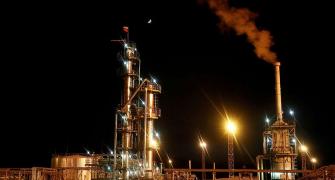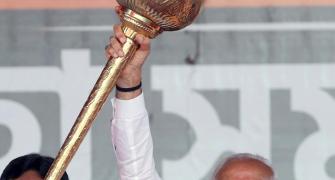Plummeting European currencies, battered by the euro zone financial crisis, are providing European aerospace corporations an opportunity to undercut their American rivals, Boeing and Lockheed Martin, in the contest to sell India 126 medium multi-role combat aircraft (MMRCA) for a price that has been estimated at $11 billion, or about Rs 44,000 crore.
The six contenders for the MMRCA contract--US companies Boeing and Lockheed Martin, Russian company MiG and European companies Dassault, Eurofighter and Gripen--will submit fresh price bids this month to India's Ministry of Defence (MoD) since their earlier bids, submitted in March 2008, were valid for just two years.
At that time, the euro was worth more than $1.55; today, it has dropped below 1.2 to the dollar, almost 25 per cent cheaper in relative terms. The Swedish krona has fallen as precipitously: worth $0.165 in March 2008, the krona is at $0.126 now. That means that a bid, calculated in euros as the equivalent of $11 billion in 2008, would be just $8-8.5 billion today, cheaper by as much as $3 billion, or Rs 13,200 crore.
Taking note of this, Enzio Casolini, the CEO of Eurofighter GmbH, the four-nation consortium that manufactures the Eurofighter, told Business Standard, "This (the drop in the euro) is important, especially in relation to the American competitors. In comparison with the dollar, we went down from more or less 1.5 (dollars to the euro) to 1.2. So, this is good "
Says Bernhard Gerwert, Board Chairman of Eurofighter GmbH, "When we launched Eurofighter's campaign in India in 2007, I thought we had only a 10 per cent chance of winning the contract. Today, I believe we have a better than 50 per cent chance of winning."
But it remains unclear whether the euro's fall has made European fighters cheap enough to win. Aerospace analysts believe that the American fighters in the fray--Boeing's F/A-18 Super Hornet and Lockheed Martin's F-16IN Super Viper--remain significantly cheaper than their European rivals. Having churned out thousands of F-16 and F-18 variants over the years, their development costs and production facilities have long been amortised.
The F/A-18 Super Hornet, going by the published US government figures, costs the US Navy between $ 40-45 million per aircraft. The F-16, being a lighter, single-engine fighter, costs significantly less than that. In contrast, the Eurofighter and the Rafale, more modern fighters that are still under development, are believed to cost upwards of $80 million apiece.
It is not just the cost of the aircraft that makes up the total value of the Indian contract. Also included in the bid price will be the cost of technology transfer, stocks of running spares, training packages, maintenance costs and technical documentation.
Complicating matters even further is the issue of "life-cycle costing". While the lowest bidder, whose aircraft passes the flight trials, will indeed win the contract, the Indian MoD has publicly declared that the lowest bid will be calculated on more than just the up-front figures on the commercial bids. Instead, the IAF would calculate the cost of each fighter over its entire service life of three decades.
Consequently, European manufacturers, with high ticket prices on their fighters, have argued that low maintenance and high availability of their aircraft mean that they work out far cheaper over their lifetime than, say, Russian fighters that have high operating costs, low reliability, and require expensive maintenance and frequent changes of parts and engines.
Now, however, IAF sources have indicated that calculating costs over three decades is proving more difficult than they had bargained for, and that the up-front value of the bid might end up as a determining factor. For the vendors, this possibility poses a dilemma in their bidding strategy. Bidding high would mean pricing themselves out of the competition, since life cycle costing would no longer be a valid argument. Bidding too low, on the other hand, could result in winning a contract that becomes a financial liability rather than a triumph.
All six competing fighters have completed their testing and evaluation by the IAF. The IAF is aiming at submitting its recommendations to the MoD by September. According to procurement rules, the MoD will then open the commercial bids of the fighters that have been found suitable by the IAF and award the contract to the lowest bidder.









